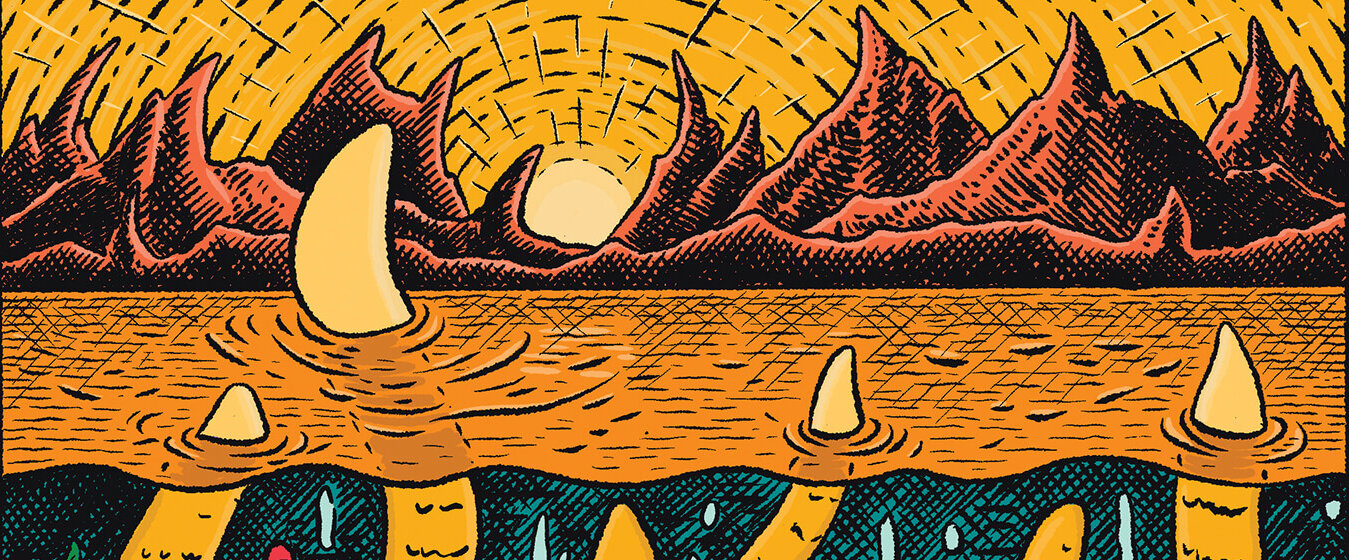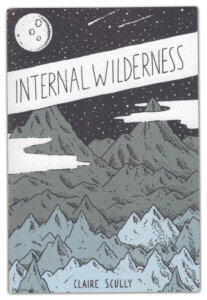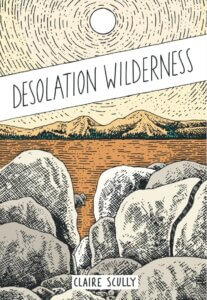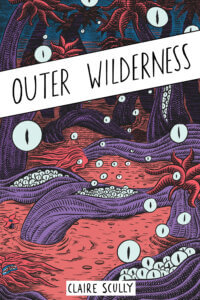London-based freelance illustrator Claire Scully goes beyond the edges of the universe in the third and final installment of her introspective journey through self-imagined places. In the Outer Wilderness, Scully invites us to step into the unknown through unique landscapes inspired by her love of science fiction, imagination, and space documentaries. As always, Scully’s work explores a myriad of themes, including humanity’s relationship with our environments. Here, she takes a moment to chat with WWAC about her illustrative journey into the Outer Wilderness.
This collection explores humanity’s relationship with our environments. How would you describe your own relationship with your environments?
It’s one of wonder and awe, I have a strong fascination for the natural world — how creative and diverse nature is, its ability to problem solve and flourish in adversity is incredibly inspiring to me. I grew up in London so for much of my life my environment has been an urban one, though London is a particularly green city often is the little signs of nature I keep my eye out for, cracks in the pavement that foster tiny plant life or the lichen that slowly over time will cover a park bench. I guess it is all about contemplation for me, quiet moments of reflection and observation.
With this being the third and final installment of the series, tell us about how the journey has evolved for you. Has this third book turned out as you expected when you first began the project?
It’s funny really as this book was made much more intentionally than the previous books — they were more curated from a big body of work, hand-picked to form a series of images. This is often how I work through a self-directed project — allowing the process of drawing inform where a series goes and letting it evolve into a cohesive body of work, it’s quite an organic way of working but it allows quite an honest interrogation of an idea or theme. Each of the illustrations for Outer Wilderness were created specifically for this book and in response to the two previous books. In the Internal Wilderness, I liked the idea of internal landscapes from your imagination that are formed from personal experience and memory, over time these places become quite fantastical and nostalgic. As I moved into Desolation Wilderness, I opened up to a more direct connection to more recent experiences and how we record and remember the atmosphere or sense of ‘place’. So for this final book it was nice to push the sense of imagination and adventure, I worked with the idea of the unfathomable scale of the universe, and though science will be able to speculate an informed idea of what might be possible in the outer reaches of the known universe there is still a sense of anything could be possible. Outer Wilderness is, I think, my most playful book so far, and the most colourful.
What are some of the documentaries that inspired this series? What was it about these documentaries that caught your attention?
I will basically watch anything relating to astronomy, good or bad, I quite like the overly dramatic ones like ‘how the universe works’ — they will often show you how you would be crushed in an instant or how all your atoms could be pulled apart. I think for me I was giving myself the opportunity to explore these worlds without my eyes exploding. I’m in awe of scientists that grasp the structures of life and how they can project theories of life across the universe with high degrees of accuracy based on what we know about the different ecosystems here on earth. I also stumbled upon an old educational Disney animation called ‘Mars and beyond’ made in the ’50s and used to teach children about the possibilities of martian life. I loved how wild the speculation of what martian life could potentially be like, I find this period of time absorbing as an age of imagination without the need for proof. So much science fiction bloomed from this period. Though with the more modern documentaries, as with most things, the more you know the more you realise the sheer volume of things that you don’t know.
As an educator, do you use your own work in your teachings? If yes, how so?
I talk about my image making practice with my students regularly, I think when teaching a subject like illustration it’s really important to share examples of best practice but I also tend to take a step away from the actual work made to talk more about finding your passion, there is no one right way of being creative but I think the long term driver for most image makers and visual communicators is a journey of making work. So much of my teaching involves helping students find 2 things, the how and the what.
- The How: finding out which physical ways of making images they really enjoy — trying to find at least a few different things (for me that is drawing, photography and collage) but also learning how to keep exploring other potential approaches as you develop — flexibility and openness to change is really useful to a long career — being able to evolve is essential, as you change your work can change too.
- And the What: finding what subject matter(s) you have a genuine interest in that will help you to keep making work, to keep asking questions on what else can you do with it, and to keep your curiosity and playfulness for the possibilities.
Tell us about some of the other projects you have in the works.
I have been really busy the past few years as an illustrator working on some big projects — I do a lot of work with museum and exhibition design companies producing the visuals for new permanent displays, this is always really challenging work and consumes quite a lot of time but often pushes my skills and challenges me to work with subject matter that I wouldn’t normally choose on my own. So I learn quite a lot from these types of projects and often this ends up filtering into my self-directed work. So with the self-direct projects I always have a few things rumbling away, I’m still working on a book called Parkland that has been an ongoing project for the last few years — it’s a bit of a documentary illustration project that sits within the comic book genre, currently without words but I’m playing around with some possibilities with that, how I might add a narration. I made a work-in-progress version of this a while back and have a short zine publication available with a selection of drawings from the main project but it’s remained unfinished for me still. I’ve also got a few little fun projects on the side that I’m playing around with — interpretations of classic movie monsters is one and a series of drawings to form a myriorama.
Outer Wilderness is available now from Avery Hill Publishing. Discover more of Claire Scully’s work at www.clairescully.com.







